Mucahid Kutlu
NativQA Framework: Enabling LLMs with Native, Local, and Everyday Knowledge
Apr 08, 2025Abstract:The rapid advancement of large language models (LLMs) has raised concerns about cultural bias, fairness, and their applicability in diverse linguistic and underrepresented regional contexts. To enhance and benchmark the capabilities of LLMs, there is a need to develop large-scale resources focused on multilingual, local, and cultural contexts. In this study, we propose a framework, NativQA, that can seamlessly construct large-scale, culturally and regionally aligned QA datasets in native languages. The framework utilizes user-defined seed queries and leverages search engines to collect location-specific, everyday information. It has been evaluated across 39 locations in 24 countries and in 7 languages, ranging from extremely low-resource to high-resource languages, which resulted over 300K Question Answer (QA) pairs. The developed resources can be used for LLM benchmarking and further fine-tuning. The framework has been made publicly available for the community (https://gitlab.com/nativqa/nativqa-framework).
GenTREC: The First Test Collection Generated by Large Language Models for Evaluating Information Retrieval Systems
Jan 05, 2025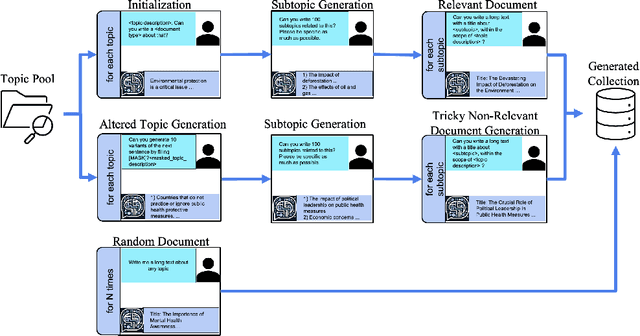
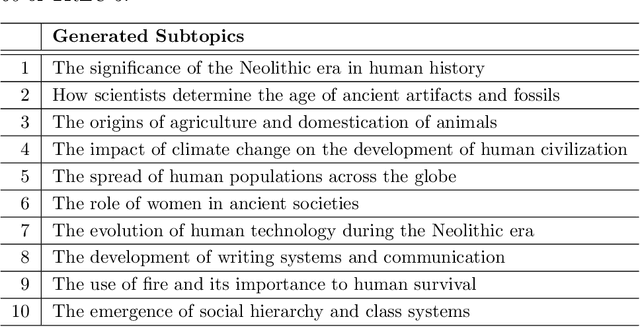
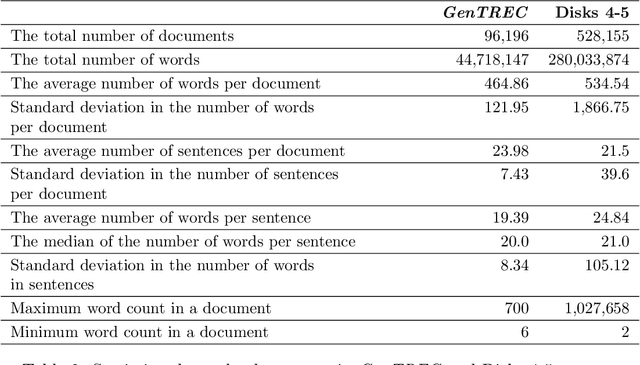
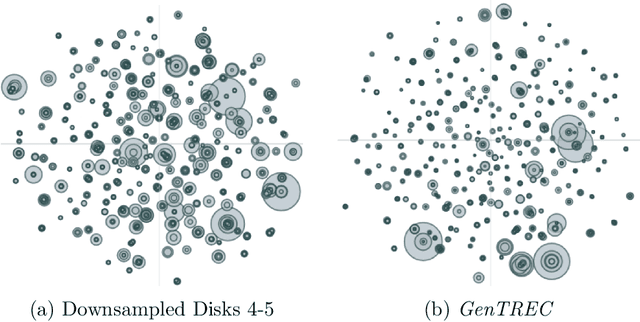
Abstract:Building test collections for Information Retrieval evaluation has traditionally been a resource-intensive and time-consuming task, primarily due to the dependence on manual relevance judgments. While various cost-effective strategies have been explored, the development of such collections remains a significant challenge. In this paper, we present GenTREC , the first test collection constructed entirely from documents generated by a Large Language Model (LLM), eliminating the need for manual relevance judgments. Our approach is based on the assumption that documents generated by an LLM are inherently relevant to the prompts used for their generation. Based on this heuristic, we utilized existing TREC search topics to generate documents. We consider a document relevant only to the prompt that generated it, while other document-topic pairs are treated as non-relevant. To introduce realistic retrieval challenges, we also generated non-relevant documents, ensuring that IR systems are tested against a diverse and robust set of materials. The resulting GenTREC collection comprises 96,196 documents, 300 topics, and 18,964 relevance "judgments". We conducted extensive experiments to evaluate GenTREC in terms of document quality, relevance judgment accuracy, and evaluation reliability. Notably, our findings indicate that the ranking of IR systems using GenTREC is compatible with the evaluations conducted using traditional TREC test collections, particularly for P@100, MAP, and RPrec metrics. Overall, our results show that our proposed approach offers a promising, low-cost alternative for IR evaluation, significantly reducing the burden of building and maintaining future IR evaluation resources.
GenAI Content Detection Task 2: AI vs. Human -- Academic Essay Authenticity Challenge
Dec 24, 2024



Abstract:This paper presents a comprehensive overview of the first edition of the Academic Essay Authenticity Challenge, organized as part of the GenAI Content Detection shared tasks collocated with COLING 2025. This challenge focuses on detecting machine-generated vs. human-authored essays for academic purposes. The task is defined as follows: "Given an essay, identify whether it is generated by a machine or authored by a human.'' The challenge involves two languages: English and Arabic. During the evaluation phase, 25 teams submitted systems for English and 21 teams for Arabic, reflecting substantial interest in the task. Finally, seven teams submitted system description papers. The majority of submissions utilized fine-tuned transformer-based models, with one team employing Large Language Models (LLMs) such as Llama 2 and Llama 3. This paper outlines the task formulation, details the dataset construction process, and explains the evaluation framework. Additionally, we present a summary of the approaches adopted by participating teams. Nearly all submitted systems outperformed the n-gram-based baseline, with the top-performing systems achieving F1 scores exceeding 0.98 for both languages, indicating significant progress in the detection of machine-generated text.
AIGCodeSet: A New Annotated Dataset for AI Generated Code Detection
Dec 21, 2024



Abstract:With the rapid advancement of LLM models, they have become widely useful in various fields. While these AI systems can be used for code generation, significantly simplifying and accelerating the tasks of developers, their use for students to do assignments has raised ethical questions in the field of education. In this context, determining the author of a particular code becomes important. In this study, we introduce AIGCodeSet, a dataset for AI-generated code detection tasks, specifically for the Python programming language. We obtain the problem descriptions and human-written codes from the CodeNet dataset. Using the problem descriptions, we generate AI-written codes with CodeLlama 34B, Codestral 22B, and Gemini 1.5 Flash models in three approaches: i) generating code from the problem description alone, ii) generating code using the description along with human-written source code containing runtime errors, and iii) generating code using the problem description and human-written code that resulted in wrong answers. Lastly, we conducted a post-processing step to eliminate LLM output irrelevant to code snippets. Overall, AIGCodeSet consists of 2,828 AI-generated and 4,755 human-written code snippets. We share our code with the research community to support studies on this important topic and provide performance results for baseline AI-generated code detection methods.
Detecting Turkish Synonyms Used in Different Time Periods
Nov 24, 2024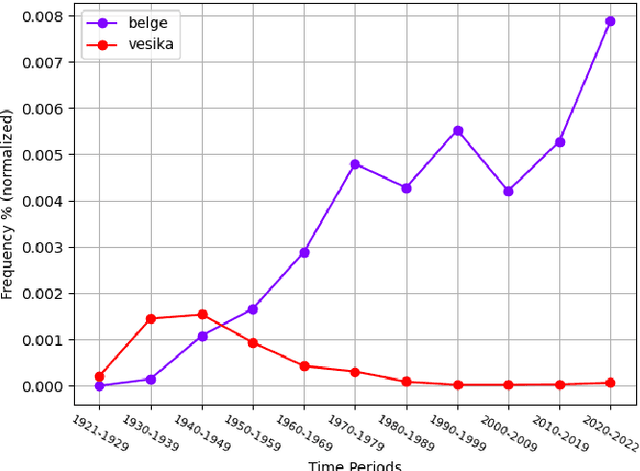
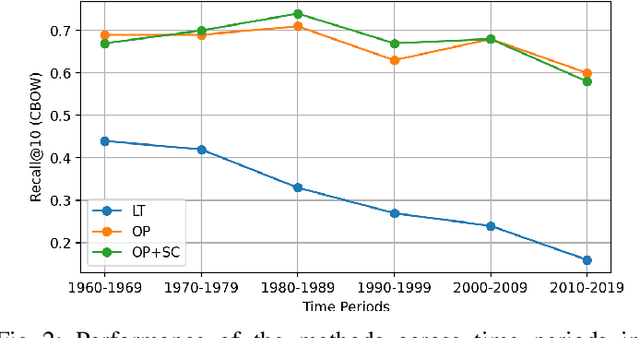
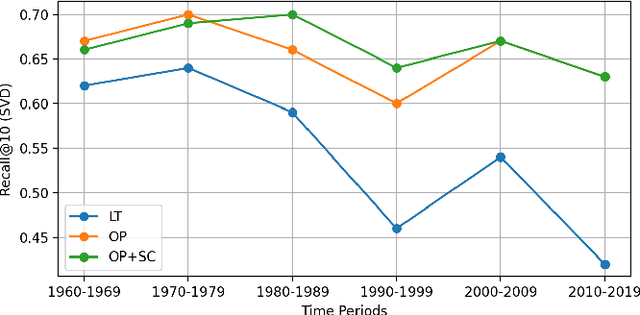
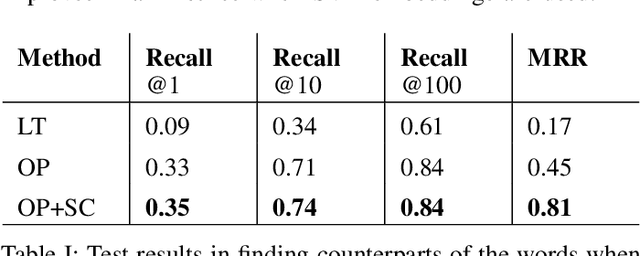
Abstract:Dynamic structure of languages poses significant challenges in applying natural language processing models on historical texts, causing decreased performance in various downstream tasks. Turkish is a prominent example of rapid linguistic transformation due to the language reform in the 20th century. In this paper, we propose two methods for detecting synonyms used in different time periods, focusing on Turkish. In our first method, we use Orthogonal Procrustes method to align the embedding spaces created using documents written in the corresponding time periods. In our second method, we extend the first one by incorporating Spearman's correlation between frequencies of words throughout the years. In our experiments, we show that our proposed methods outperform the baseline method. Furthermore, we observe that the efficacy of our methods remains consistent when the target time period shifts from the 1960s to the 1980s. However, their performance slightly decreases for subsequent time periods.
NativQA: Multilingual Culturally-Aligned Natural Query for LLMs
Jul 13, 2024Abstract:Natural Question Answering (QA) datasets play a crucial role in developing and evaluating the capabilities of large language models (LLMs), ensuring their effective usage in real-world applications. Despite the numerous QA datasets that have been developed, there is a notable lack of region-specific datasets generated by native users in their own languages. This gap hinders the effective benchmarking of LLMs for regional and cultural specificities. In this study, we propose a scalable framework, NativQA, to seamlessly construct culturally and regionally aligned QA datasets in native languages, for LLM evaluation and tuning. Moreover, to demonstrate the efficacy of the proposed framework, we designed a multilingual natural QA dataset, MultiNativQA, consisting of ~72K QA pairs in seven languages, ranging from high to extremely low resource, based on queries from native speakers covering 18 topics. We benchmark the MultiNativQA dataset with open- and closed-source LLMs. We made both the framework NativQA and MultiNativQA dataset publicly available for the community. (https://nativqa.gitlab.io)
Turkronicles: Diachronic Resources for the Fast Evolving Turkish Language
May 16, 2024



Abstract:Over the past century, the Turkish language has undergone substantial changes, primarily driven by governmental interventions. In this work, our goal is to investigate the evolution of the Turkish language since the establishment of T\"urkiye in 1923. Thus, we first introduce Turkronicles which is a diachronic corpus for Turkish derived from the Official Gazette of T\"urkiye. Turkronicles contains 45,375 documents, detailing governmental actions, making it a pivotal resource for analyzing the linguistic evolution influenced by the state policies. In addition, we expand an existing diachronic Turkish corpus which consists of the records of the Grand National Assembly of T\"urkiye by covering additional years. Next, combining these two diachronic corpora, we seek answers for two main research questions: How have the Turkish vocabulary and the writing conventions changed since the 1920s? Our analysis reveals that the vocabularies of two different time periods diverge more as the time between them increases, and newly coined Turkish words take the place of their old counterparts. We also observe changes in writing conventions. In particular, the use of circumflex noticeably decreases and words ending with the letters "-b" and "-d" are successively replaced with "-p" and "-t" letters, respectively. Overall, this study quantitatively highlights the dramatic changes in Turkish from various aspects of the language in a diachronic perspective.
I Know You Did Not Write That! A Sampling Based Watermarking Method for Identifying Machine Generated Text
Nov 29, 2023

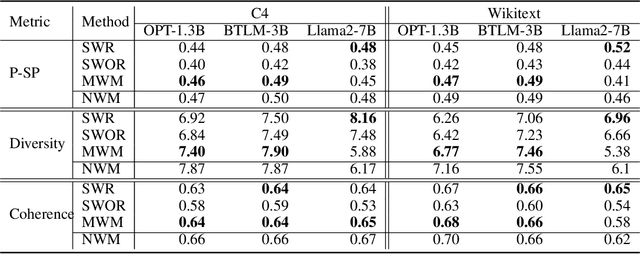

Abstract:Potential harms of Large Language Models such as mass misinformation and plagiarism can be partially mitigated if there exists a reliable way to detect machine generated text. In this paper, we propose a new watermarking method to detect machine-generated texts. Our method embeds a unique pattern within the generated text, ensuring that while the content remains coherent and natural to human readers, it carries distinct markers that can be identified algorithmically. Specifically, we intervene with the token sampling process in a way which enables us to trace back our token choices during the detection phase. We show how watermarking affects textual quality and compare our proposed method with a state-of-the-art watermarking method in terms of robustness and detectability. Through extensive experiments, we demonstrate the effectiveness of our watermarking scheme in distinguishing between watermarked and non-watermarked text, achieving high detection rates while maintaining textual quality.
New Metrics to Encourage Innovation and Diversity in Information Retrieval Approaches
Jan 24, 2023



Abstract:In evaluation campaigns, participants often explore variations of popular, state-of-the-art baselines as a low-risk strategy to achieve competitive results. While effective, this can lead to local "hill climbing" rather than more radical and innovative departure from standard methods. Moreover, if many participants build on similar baselines, the overall diversity of approaches considered may be limited. In this work, we propose a new class of IR evaluation metrics intended to promote greater diversity of approaches in evaluation campaigns. Whereas traditional IR metrics focus on user experience, our two "innovation" metrics instead reward exploration of more divergent, higher-risk strategies finding relevant documents missed by other systems. Experiments on four TREC collections show that our metrics do change system rankings by rewarding systems that find such rare, relevant documents. This result is further supported by a controlled, synthetic data experiment, and a qualitative analysis. In addition, we show that our metrics achieve higher evaluation stability and discriminative power than the standard metrics we modify. To support reproducibility, we share our source code.
Catch Me If You Can: Deceiving Stance Detection and Geotagging Models to Protect Privacy of Individuals on Twitter
Jul 23, 2022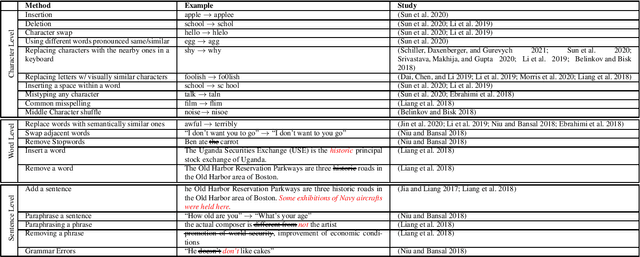
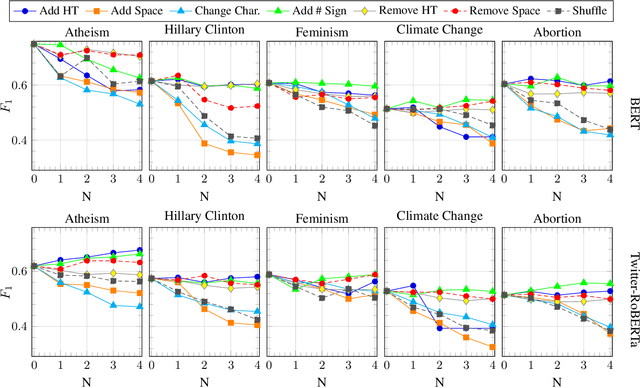
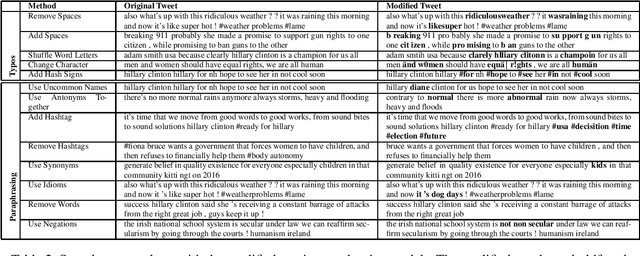
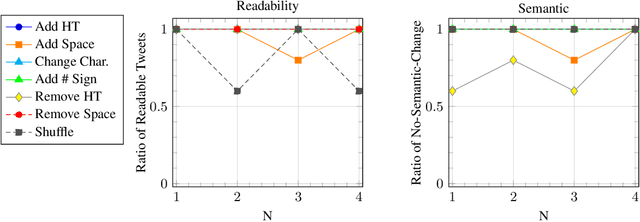
Abstract:The recent advances in natural language processing have yielded many exciting developments in text analysis and language understanding models; however, these models can also be used to track people, bringing severe privacy concerns. In this work, we investigate what individuals can do to avoid being detected by those models while using social media platforms. We ground our investigation in two exposure-risky tasks, stance detection and geotagging. We explore a variety of simple techniques for modifying text, such as inserting typos in salient words, paraphrasing, and adding dummy social media posts. Our experiments show that the performance of BERT-based models fined tuned for stance detection decreases significantly due to typos, but it is not affected by paraphrasing. Moreover, we find that typos have minimal impact on state-of-the-art geotagging models due to their increased reliance on social networks; however, we show that users can deceive those models by interacting with different users, reducing their performance by almost 50%.
 Add to Chrome
Add to Chrome Add to Firefox
Add to Firefox Add to Edge
Add to Edge